“Fortune favours the bold.” ~ Latin proverb.
What are the unspoken do’s and don’ts in Japan? Its unique culture having been isolated from the outside world for 200 years, it leaves many tourists intrigued and wanting to visit!
Although, there are a few burning questions most foreigners nervously ask before visiting Japan: What is the Japan etiquette for tourists? Is it going to be difficult to avoid looking like a tourist? Especially if I have Western heritage?
Considering expats only make up 1.5% of Japan’s population (and Westerners only contributing to 0.01% of that!) it seems the odds are stacked against you. Never fear, I’ve created this Japanese etiquette guide to show you they don’t have to be… It’s how you act that will give you away!
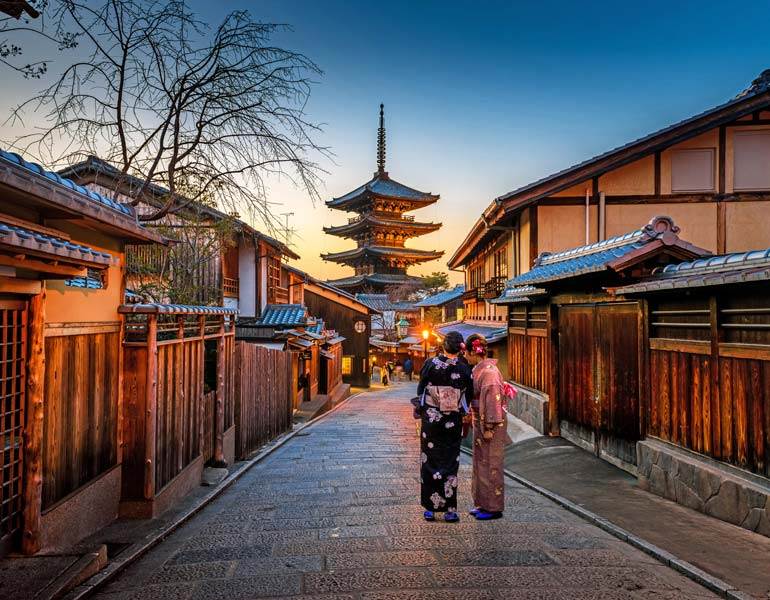
I’ve visited Japan multiple times over the past decade (and shared my personal itineraries, language guides, packing lists and more on my Japan travel blog), as well as worked with Japanese colleagues in my previous and current job. Therefore, I am well-versed in Japanese etiquette in order not to unintentionally cause offence to locals. I’ve learnt so much over the years and am about to reveal it all to you!
This guide to rough rules for tourists in Japan will help you better “blend in.” You’ll also learn how to prepare for a trip to Japan and travel in a respectful, mindful way with these Japanese manners. In turn, this means you’ll have the most enjoyable trip possible.
If you want to learn what not to do in Japan as a tourist and all the things to know before visiting Japan, read on for more!
This post contains affiliate links, at no extra cost to you. I may earn a small commission if you click through and make a purchase.
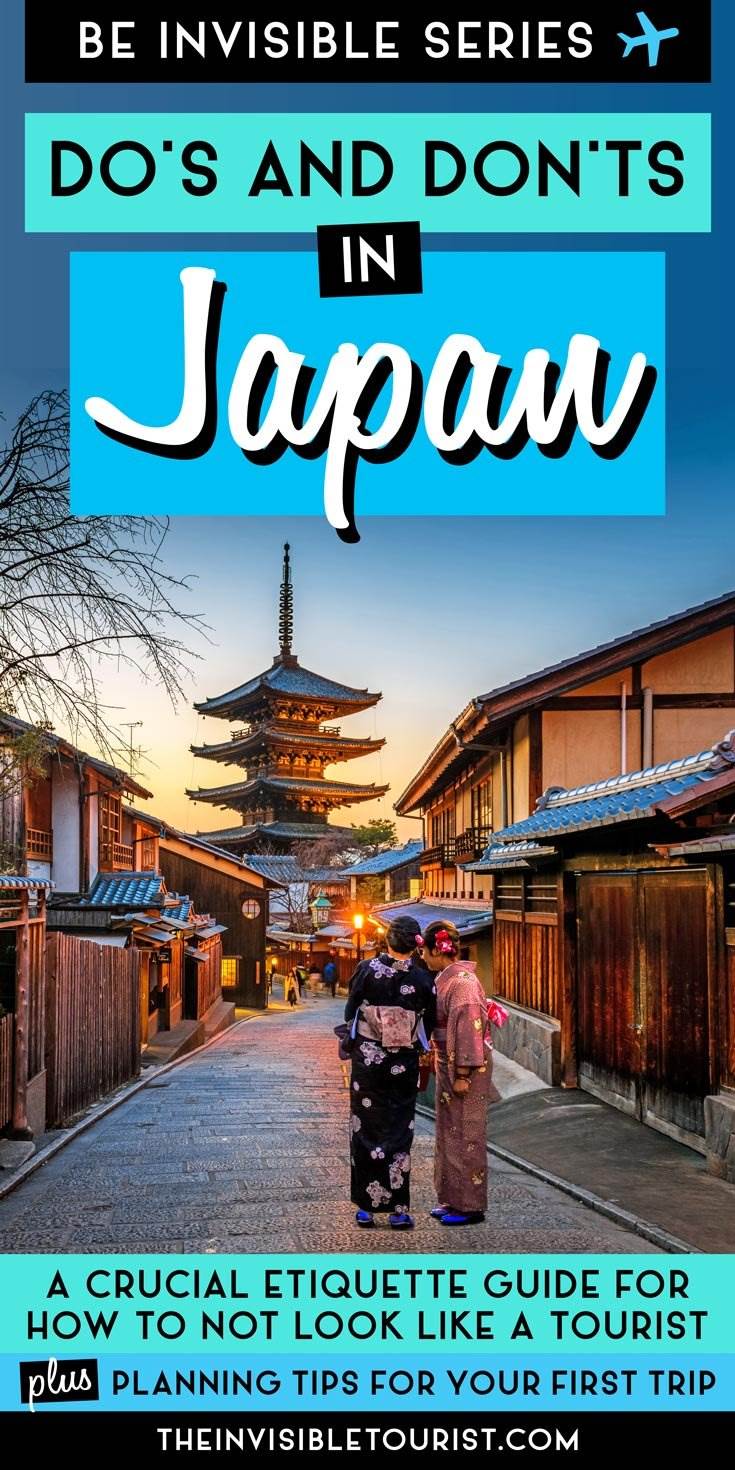
Japanese Etiquette: Do’s and don’ts in Japan to avoid being an annoying tourist
Did you know inbound tourism to Japan tripled in just six years fro 2013 – 2019? The ever-increasing number of visitors to Japan in this short timeframe meant there were some bad tourists in the bunch, causing more harm than good to Japan’s delicate social fabric.
Let’s be real, no one likes an annoying tourist. This is why I literally wrote a #1 Amazon New Release book for how to avoid being one in Japan and at any destination.
Being a proud mono-ethnic culture means that Japanese etiquette, customs, beliefs and traditions dating back centuries are highly respected and practiced in day-to-day life.
These are the things tourists love so much (or maybe it’s just the interesting photos they’ve seen on Instagram), but the ultra conservative island nation became a victim of its own success until early 2020.
|

If you’re passionate about preserving and embracing local cultures instead of unintentionally damaging them, you’re going to find these tips for etiquette in Japan for tourists invaluable. Especially if you’re travelling to Japan for the first time!
Let me tell you, as a gaijin in Japan 外人 (foreign person), I actually manage to blend in quite well by practising these simple points, and knowing the reasons why they are important.
By following these do’s and don’ts in Japan, you can travel confidently by being prepared and knowing how to avoid any lingering looks of disapproval from locals by doing something wrong you weren’t aware of.
Ignorance isn’t always bliss!
30 Crucial Do’s and Don’ts in Japan to Not Look Like a Tourist
It’s SUPER essential to find out any cultural differences before your trip so you know what not to do in Japan. What’s completely acceptable at home may certainly not be in Japan! So, let’s get stuck into the do’s and don’ts of things to do (or avoid) when in Japan:
1. Don’t walk around eating or smoking
Eating while walking around between attractions may seem like you’re killing two birds with one stone, however this is considered quite rude in Japan. Accidentally spilling your coffee or dropping that piece of sushi on the ground may lead to someone treading in it and ruining their day.
You’ll notice convenience stores such as Lawson and Family Mart have designated seating areas for you to eat so there’s no need to walk and munch. This attitude for being respectful of others is held towards smoking as well.
If you’re from Singapore you’ll already be familiar with this idea, but for those of you who aren’t, it’s polite to stand in one spot while smoking or head to a designated smoking area found outdoors in Japan. People will even patiently queue up to go in!
The idea behind these areas is to prevent people waving their smoke around in the faces of unsuspecting people. Again, it’s all about showing consideration for people around you.
TIP: Another thing to note about smoking: In some establishments it’s still perfectly legal to smoke indoors and around food. If you’re not comfortable with this, simply ask for the non-smoking area when you’re being seated at a restaurant.

2. Don’t misuse your chopsticks
Chopsticks have quite a few symbolic meanings that should be observed in Japan. If you have an Asian heritage you may already be familiar with some. I could write an entirely separate post about chopsticks but to quickly sum it up:
- Don’t stick your chopsticks upright in your rice bowl. This is a taboo in Japan as this ritual is reserved for funeral services. It is disrespectful to do this otherwise as it can be reminder of death or bad luck. It’s also impolite to cross them.
- Don’t pass food to another person with chopsticks that have touched your mouth. This isn’t very hygienic but if you’d like your travel buddy to sample what you’re eating, use the other end of the chopsticks to place a piece on a small plate and pass it over.
- Don’t rub your chopsticks together. The single-use wooden chopsticks you receive that need to be broken apart before use are only seen to have splinters if they are of cheap quality. Rubbing them together implies to the establishment you believe their chopsticks aren’t up to scratch.
- Don’t stab pieces of food with your chopsticks. This is bad manners in Japan and not how chopsticks are intended to be used.
- Do place your chopsticks back on the hashioki 箸置き (chopstick rest) when not in use. This will ensure they stay clean and don’t roll off the table.
- Do read this quick instruction guide if you’ve not learnt how to hold chopsticks yet!

READ MORE:
3 Weeks in Japan Itinerary: Sights & Culture Off the Beaten Track
Secret Tokyo Hidden Gems you’ve Never Heard Of
Hiroshima to Miyajima: Why It’s Worth a Day Trip by Ferry
What’s it Really Like Taking an Authentic Kyoto Cooking Class?
3. Don’t approach geisha or maiko for selfies
This is one of the rules in Japan for tourists that is imperative to know beforehand. To some tourists in Gion, Kyoto, it seems like the obvious option prompting geisha for the perfect selfie to showcase across social media. However, it may be surprising to learn this is NOT acceptable behaviour in Japan.
While they are one of many things Japan is famous for, these graceful ladies are not tourist attractions or celebrities. They are in their working environment hurrying from one engagement to another and have been doing so for centuries. To approach them or hold them up is incredibly rude, one of the most disrespectful things to do in Japan and may make them upset or late.
Instead…
For those wanting to check a geisha photo off their Japan bucket list, you may see “fake” geisha in the streets who are not in a rush and happy to take photos. Otherwise, please book an official meeting with one to support their craft.
TIP: There are also various cultural experiences in Japan where you can meet maiko and geisha, so be sure to take a look at my guide to meeting a geisha in Tokyo experience.
NOTE: As a visitor to Japan, it is completely acceptable to wear kimono or yukata. In fact, there are many kimono rental stores catering to tourists for this exact purpose! You’ll see domestic and foreign tourists wearing kimono in traditional cities such as Kyoto, at onsen towns in Japan (hot springs) and when staying in ryokans (traditional Japanese inns). Locals love when foreigners embrace their traditional dress, so you’ve nothing to worry about!

4. Don’t harass the sacred deer at Nara or Miyajima Island
Although these furry friends seem harmless, don’t be fooled into thinking they won’t pack a punch when annoyed. In recent years, there was an increasing number of deer-related tourist injuries as visitors lusted after flawless selfies.
So much so, tourists to Nara have been known to taunt deer with food to lure them over and not follow through, much to the annoyance of these wild animals who kick and bite in response.
You’d be annoyed too if someone promised food then relentlessly shoved a camera in your face instead. Additionally, visitors have been feeding deer human snacks that make them sick.
Instead…
Remember these are wild animals. Buy some deer food from a local vendor for JPY 200 and be mindful about how you approach the deer. Don’t make deer wait for a cracker as this will only aggravate them. The older ones have learnt it’s polite to bow first!
TIP: When the tourists stopped coming from 2020-2022, the deer at Nara learnt their natural foraging habits again.
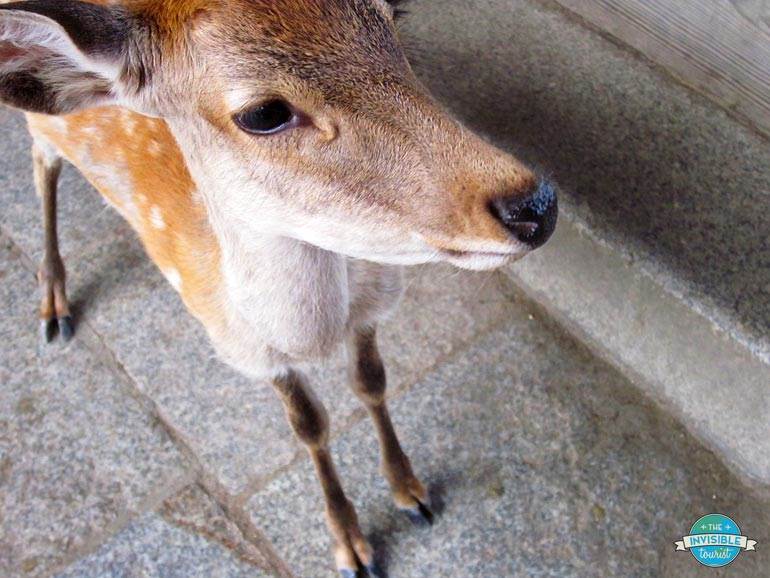
5. Don’t deface significant UNESCO World Heritage sites
The giant emerald-green bamboo groves in Arashiyama are a huge drawcard for Kyoto’s visitors. Unfortunately for Sagano Bamboo Forest, it’s been revealed that tourists etched their names into over 100 of the lush stems, much like leaving a love lock on a Parisian bridge.
This isn’t romantic, it’s a form of vandalism. Being connected by their roots, if one bamboo tree is damaged it can lead to many others being affected too, which could mean the entire area being closed off to tourists altogether. What’s the logic in harming something we love?
Instead…
Admire the elegant bamboo stems from afar and take some wonderful photos as mementos.

6. Don’t over-indulge in obvious Western places with free wifi like Starbucks
This may be one of the controversial do’s and don’ts of Japan! Come on, we don’t go all the way to Japan to sip on a pumpkin spice latte while fumbling on our phones for hours on free wifi… do we?
Especially for a short trip, if you want to not look like a tourist in Japan steer away from the obvious imported watering holes like Starbucks and McDonald’s.
Instead…
Head to an izakaya (居酒屋), a Japanese-style pub that serves alcoholic drinks and Japan’s version of tapas: Lots of small, tasty Japanese dishes that will get your mouth watering!
Kirin City in my Tokyo itinerary is a great example of this and you’ll find many locals hanging out in these kinds of places for after work drinks.
Why not embrace traditional beverages like matcha tea, sample local beers, sake and be in the moment rather than posting constant updates on social media?
Even better, why not go on a fun food tour with a local guide? I’ve done many small group tours in Japan, they’re always a great way to meet other travellers. The best part is you don’t need to worry about what to order because your guide has it all under control!
TIP: I’ve reviewed quite a few experiences now, I put together a detailed guide to the best food tours in Tokyo you’ll absolutely love!
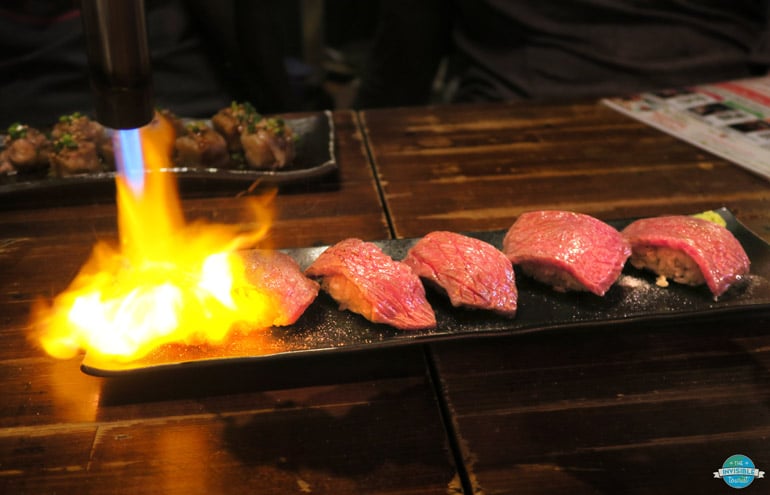

7. Do learn some basic Japanese phrases
No one is saying you have to become fluent. I certainly am not! Just being able to read some of the basics when getting around on the metro or ordering from a Japanese menu is one of the factors that will set you apart from other tourists in Japan.
The added bonus is the look of delight on a local’s face when you greet and address them in their native tongue is nothing short of awesome. It’s also handy to learn the meanings of some expressions such as omotenashi, shinrin yoku and more in my guide to beautiful Japanese words you can use during your trip.
I’ve made this even easier for you with my easy guide to Japanese for tourists, with FREE downloadable cheat sheet to use offline when you’re in Japan! ⬇️

8. Do slurp your noodles
Oh, the sour looks of condemnation you would receive in many countries for doing this – not so in Japan!
In fact, the louder you slurp, it’s considered as a compliment to the chef. So slurp, slurp SLURP away ’til your heart’s content.
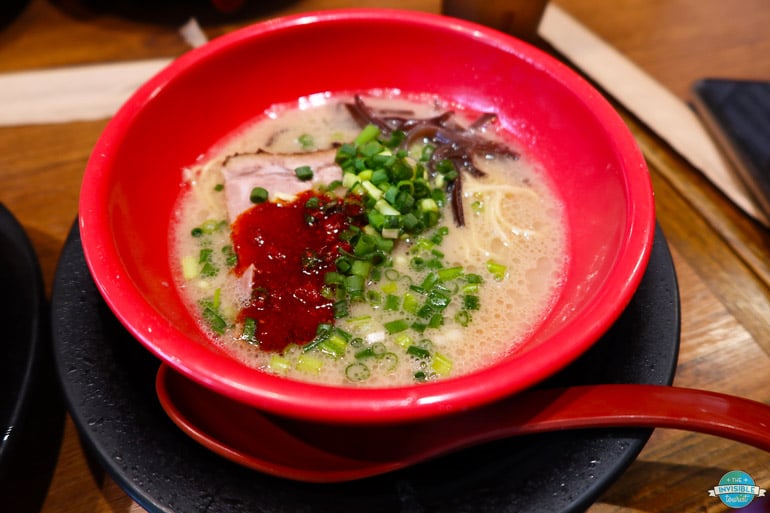
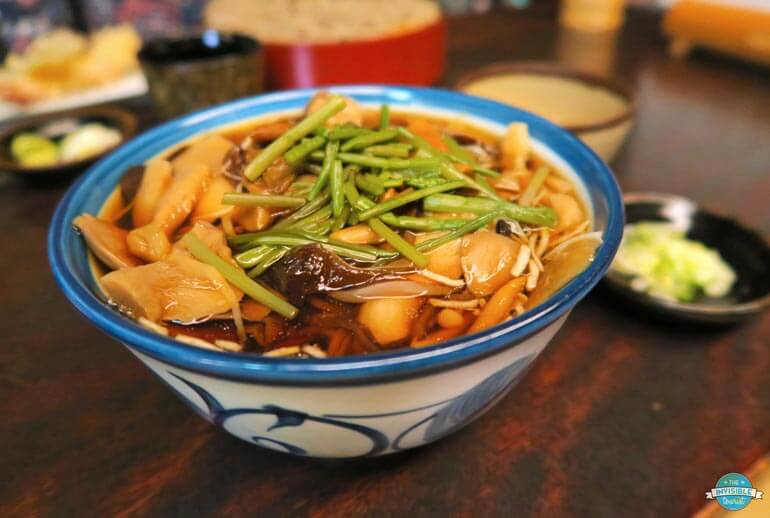
9. Don’t leave a tip or count your change
Omotenashi refers to the high level of courtesy and politeness that is deeply ingrained into customer service in Japanese culture. Although we may mean well by leaving a tip as this is expected in many countries, in Japan leaving some coins behind can be considered insulting.
It can imply we’re paying staff for providing good service when it is expected as standard, not done for monetary reward. In some cases staff may even chase after us thinking we’ve forgotten our change! Please don’t insist, as this can make people feel awkward and uncomfortable.
Additionally when purchasing goods or services, change will be given on a little tray. Resist the temptation to count it out as this can also be considered as rude.
Unlike many destinations around the world where tourists are almost there just to be ripped off, thankfully Japan does not see tourists this way. Rest assured that people are being honest, not out to get us and our change will be correct.
TIP: When paying for items, place your cash on the little tray rather than placing it in the person’s hands. This is what locals do.

10. Do bow appropriately
Bowing is a very important part of Japanese culture so it’s best to mirror the locals. There are different bows used for different situations, but as a tourist in Japan the most useful bows you can use are when you’re:
- Meeting and greeting people
- Thanking someone
- Saying sorry to someone
When bowing, be sure not to curve your back and neck. Think of it as bending forward with your hips and keeping your back straight with hands by your sides.
It’s also polite in some situations to nod your head in thanks. Find out more details on bowing in Japan here.
When I’ve returned home from my Japan trips, it takes me a day or so to get out of this habit! I’ve even bowed when talking to someone in Japan on the phone, haha.
TIP: Generally, a good indication of when to bow is when someone bows to you!

11. Do take advantage of public transport
It’s not difficult to use public transport in Japan, I promise! I’ve travelled as part of a couple, solo, on business and for leisure, and I mean it when I say the public transport in Japan is AMAZING.
Hiring a private car to drive around Japan can be expensive. Not to mention cars drive on the LEFT (more on this down the page). Did you know there has been a sharp increase in tourist hire car accidents in recent years?
Many visitors are not be used to driving on the left, so the added concentration required combined with Japanese roadsigns and rules may make driving a stressful situation. I’d say you only really should hire a car if you’re planning to visit more rural areas.
TIP: If following my 3 week Japan itinerary, a car and private transport are not needed at all.
As some of the world leaders in technology, Japan is very well connected by public transportation systems so it’s a great idea to take advantage of them. The metro systems in major cities like Tokyo, Kyoto and Osaka are inexpensive and will efficiently get you to most of the major sights or from one side of the city to the other.
Buses are also very reliable, but no trip to Japan would be complete without a trip (or few) on the shinkansen – the incredible bullet trains that can reach speeds in excess of 300km/h!
Read more about the different shinkansen and the kinds that are not covered by the Japan Rail Pass (JR Pass) for tourists.
TIP: If you’re catching a taxi in Japan, note that the back left door will open automatically. And for my fellow Aussie readers who sometimes sit in the front of a taxi at home, remember in Japan you’ll need to sit on the back seat instead.
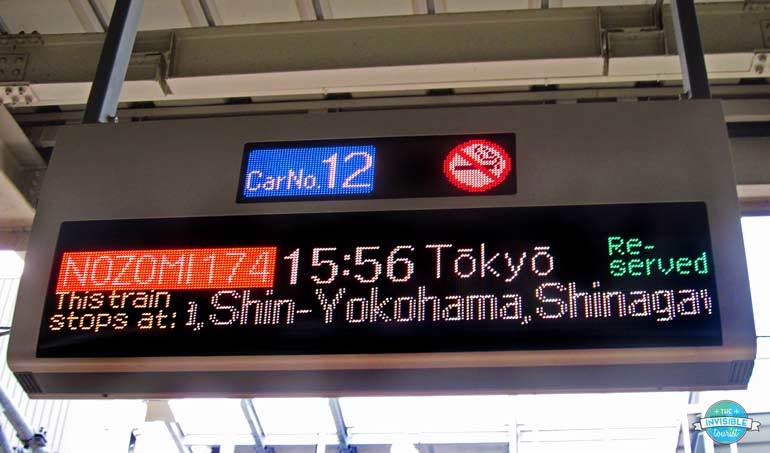
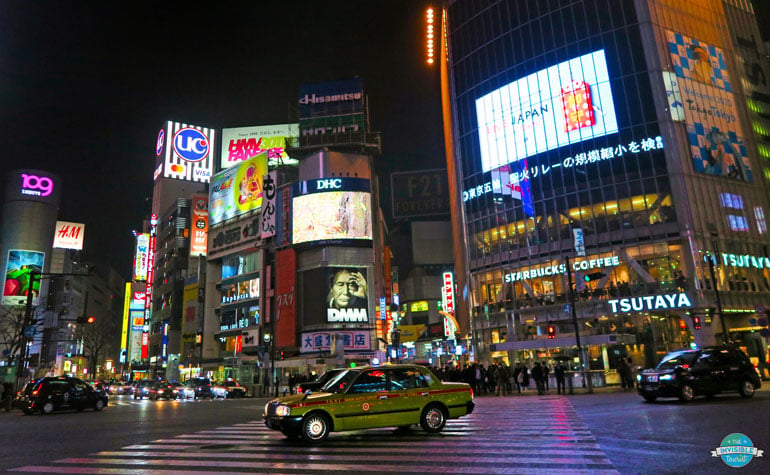
12. Do be quiet on the bullet and metro trains
Getting back to the consideration for others thing – It’s a big no-no to make or accept phone calls on trains in Japan. This also applies to playing loud music and speaking at a high volume.
Even crying babies are whisked away by their parents to the areas between carriages on the shinkansen to avoid disturbing fellow passengers.
But why? Many tired commuters who work long hours use this time to catch up on sleep, so quiet carriages are important.
I’m sure you can relate to having to endure a loud debate from that ignorant person yelling down the phone in the train carriage back home, wishing they would put a sock in it. Urgh.
Place your phone on silent and simply reject calls until you alight the train, or if you’re on a shinkansen and it’s important head to the boarding area between the carriages.
TIP: Speaking of train etiquette in Japan, it’s polite to line up at the station platform in the indicated areas and board as you would a plane.
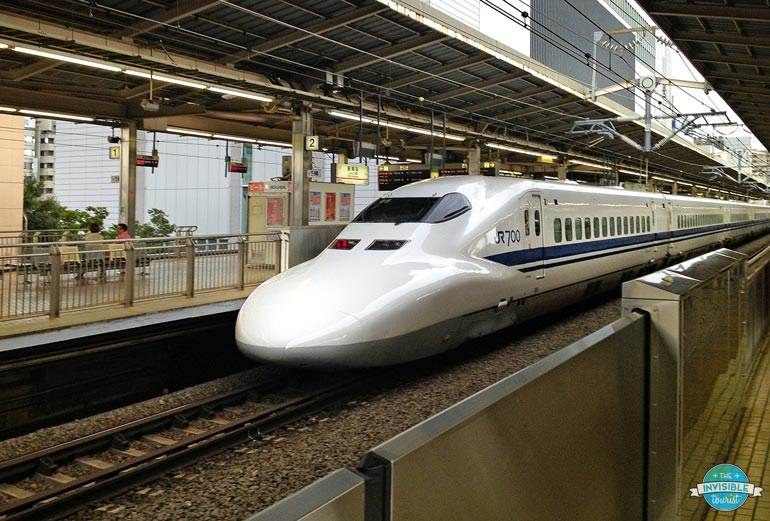

13. Do use two hands to accept business cards
In Japan, business cards are very important little pieces of matter and believe it or not, need to be treated with respect. They are actually thought of as an extension of the person.
If you give or receive a business card, pass/accept it with two hands, thumbs facing up, and politely give a nod of thanks. When receiving a business card, study it thoughtfully then leave it on the table in front of you, or hold onto it until after your meeting.
I’m guessing you wouldn’t like the thought of the person you’ve just met cramming a miniature you into their back pocket before squashing you with their body weight as they sat down, correct? Most locals carry card holders specifically to place business cards in, too.
TIP: I do this with my important cards and documents too, such as credit cards and passport. You may notice this is how locals hand back these things to you as well.
14. Do walk, drive and ride on the left
As one of only 78 countries in the world, you may be surprised to learn that cars drive on the left-hand side of roads in Japan. Bicycles and pedestrians also naturally keep to the left in the streets (which for me as an Australian was a real treat for once!)
Be sure to follow suit and keep out of the way, including on escalators and staircases. You’ll find Japan is a very punctual country and you stopping in the middle of the footpath and getting in someone’s way will not go down well.
You don’t want to be the reason for someone running late. Again, it’s about showing consideration for other people and their time.
TIP: One exception to keeping left is in Osaka. People tend to keep right! It’s believed this habit dates back to medieval times when samurai carried their swords on their left hip. To prevent accidentally hitting others with their swords, they walked on the left. Osaka was a city of merchants, and therefore people carried their bags in their right hands and naturally kept right when walking.
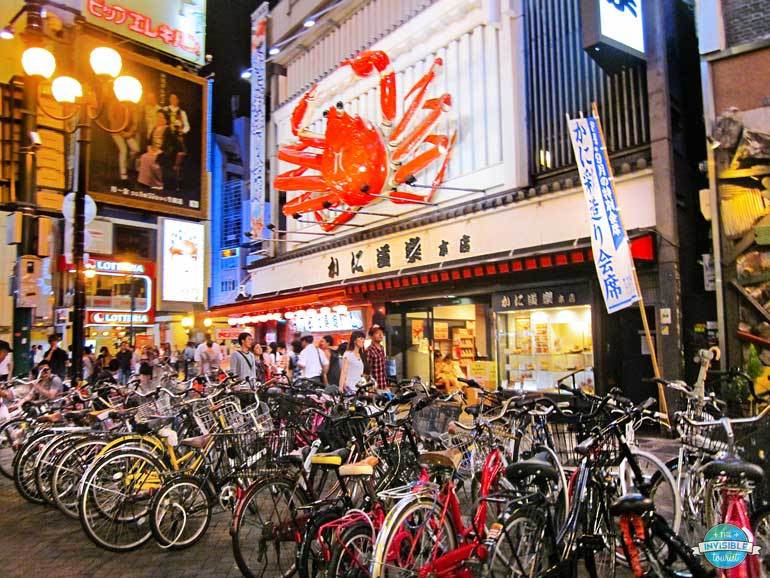
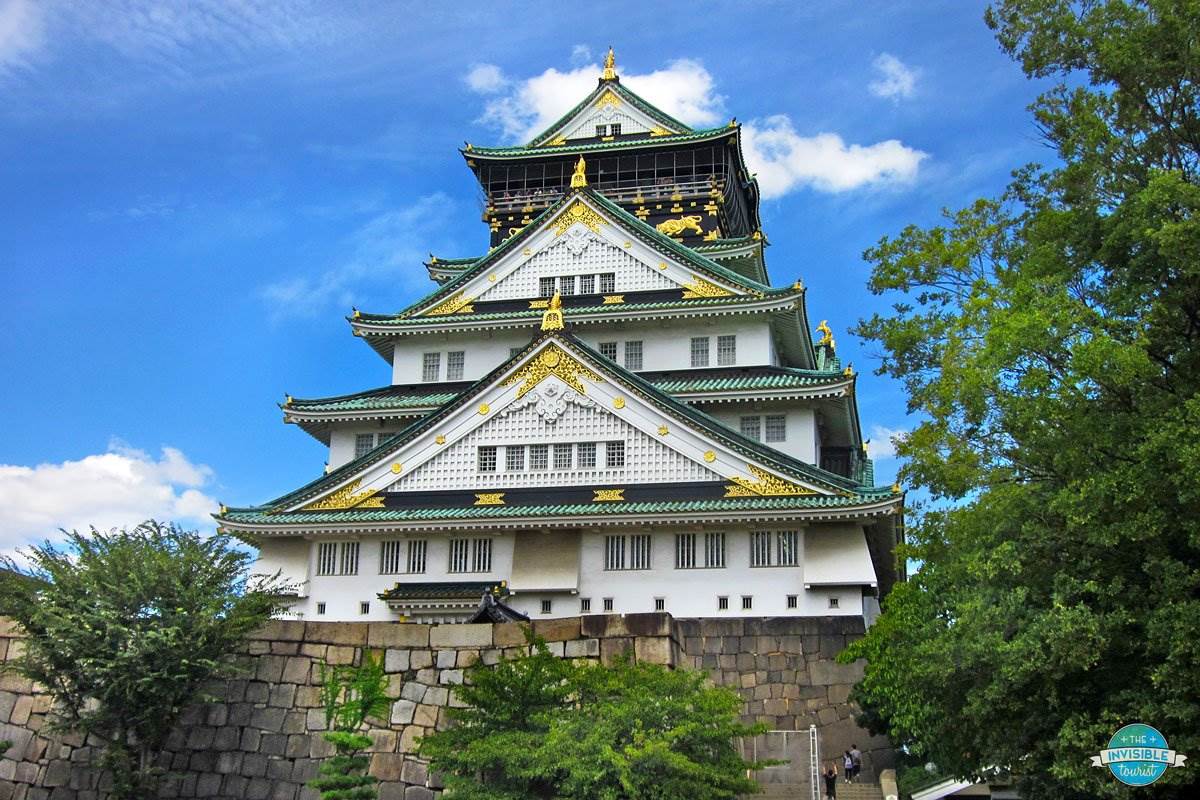
15. Do say “kanpai” when clinking your glasses before drinking
To really act like a local in Japan, be sure to take part in the drinking culture. An alcoholic drink is considered well deserved after a hard day at work (or sightseeing, if you’re a visitor!)
Before taking a sip of an alcoholic drink, it’s another one of the unspoken Japan rules to make a toast and say kanpai かんぱい. This translates to “dry glass” or “empty glass,” much like the English equivalent of “bottoms up.”
TIP: Before eating a meal, it’s polite to say itadakimasu いただきます, translating to “I humbly receive.” This is a way of saying thanks and showing appreciation for the meal.
You don’t have to drink it all it all in one hit, though! In fact, Japan’s national beverage sake (pronounced sa-keh 酒 but known as Nihonshu 日本酒 in Japan) is best appreciated by drinking it slowly.
There is a bunch of Japanese etiquette to know when drinking with colleagues or in a business environment. Take a read of my guide to hidden bars in Shibuya or hidden bars in Kyoto with locals for more.
TIP: One of the things not to do in Japan when it comes to pouring sake is NEVER pour your own! Asking someone to pour it for you is the correct etiquette, and you can return the favour.

16. Do embrace Japanese vending machines
Did you know there’s a vending machine for every 1 in 23 people in Japan? There’s a whopping 5.5 million machines dotted throughout the country dispensing anything you can think of.
From ice cream to umbrellas, hot noodles to sake, eggs to bananas, the options are endless! Even at some restaurants, you can place your meal order on a vending machine, take a seat and your meal is brought over to you shortly after.
You will find them almost everywhere across Japan — even in what seems the middle of nowhere, like this one in the outskirts of Kyoto pictured above!
Did you even visit Japan if you didn’t use one?
TIP: If you are at a restaurant that requires you to use a vending machine to order and you’re unsure of what to choose, the top left is usually the specialty dish.


17. Don’t blow your nose loudly in public
Quite the opposite of Western culture, sniffing is the preferred option in Japan as it is seen as less rude and crude than blowing your nose loudly.
If you find your nose starting to trickle it’s acceptable to discreetly turn away from a crowd and wipe it with a tissue.
Take advantage of vendors handing out free pocket tissues on the streets as advertising for their businesses.
If it’s all getting too much and you absolutely need to blow your nose, find a restroom to do this and dispose of your tissues in the bin located inside.
TIP: Handkerchiefs and furoshiki cloths are reserved for wiping sweat or drying hands after washing.

18. Don’t jaywalk
Rules are followed and obeyed in Japan, which is probably why the country runs so smoothly. The origins of why it’s illegal to jaywalk in Japan are unclear, but from what I could gather in my research it could be due to the fact that people are quite trusting.
When standing at a crowded street corner waiting for the light to change, if one person sees another start crossing the road out of the corner of their eye they may assume it must be safe to cross and blindly follow the person crossing, which can be very dangerous.
It could also be because locals don’t want to set a bad example to children.
If you know the reason, let me know in the comment section below!
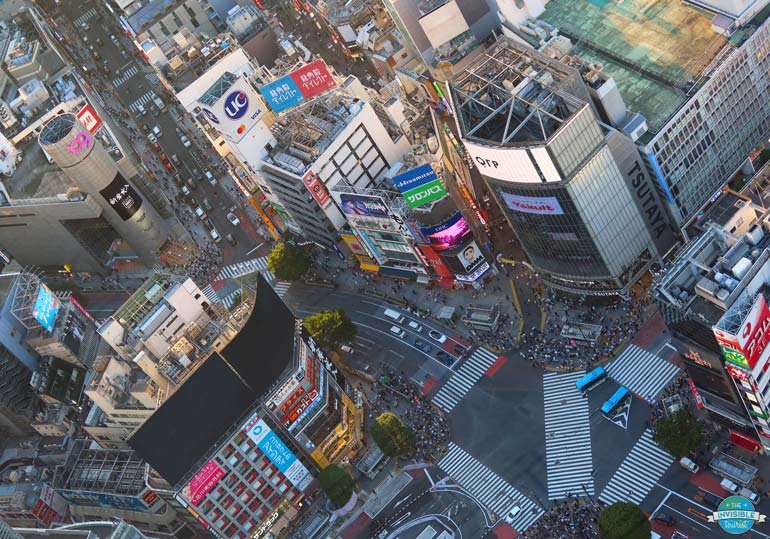
19. Do hang on to your rubbish
Bins are typically hard to find on the streets of Japan, but despite this everywhere is amazingly litter-free. This is because people hang on to their rubbish in Japan as they appreciate cleanliness.
Also, there isn’t a need for bins everywhere because people don’t walk around eating, drinking or smoking as mentioned in point #1.
Bins can be found at convenience stores (more on this below), alongside vending machines and in public toilets. It’s advisable to carry your rubbish until you find a bin, or take it back to your hotel and dispose of it there.
Resist any temptation to litter despite the lack of bins and do as the locals do.
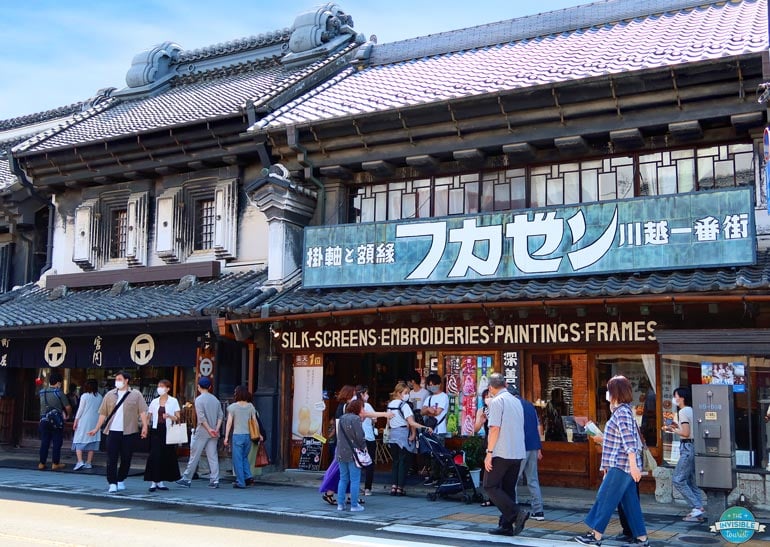
20. Do try the amazing food at convenience stores
Prepare to break all your pre-conceived stereotypes that convenience store food is stale, tasteless rubbish. Your mind will be blown away by the high quality (and variety) of food and snacks available in konbini stores like Family Mart, 7-11 and Lawson in Japan – it’s all super fresh as well!
If you’re after a quick, wholesome and cheap bite to eat look no further than the convenience store. Satisfy your hot food cravings with options like pork steam buns, karaage chicken, hot stews and noodles. You can also pick up chuhai チューハイ (canned alcoholic drinks) for cheap.
Refrigerated goodies include sushi, onigiri, iced coffees and frappes. Delicious baked goods, desserts and even alcoholic beverages are available. Trust me when I say the egg sandwiches from 7-11 are the best you will ever have in your life!
TIP: You can always ask staff to warm up meals in their microwave!
I honestly cannot articulate how amazing the quality of food is available at these convenience stores, do go see for yourself. Lawson in particular pride themselves on introducing a new food or beverage product every week to mix things up a little.
Don’t forget to sit at the designated tables inside instead of walking around the streets, and dispose of your rubbish in the store’s bins before you go.
TIP: Convenience stores are a great place to withdraw cash from the ATM’s located inside. Instead of exchanging money at a currency exchange, withdrawing from an ATM directly will mean you’ll receive the best exchange rate.


21. Don’t be afraid of the toilets
Don’t knock it ’til you’ve tried it! Get excited to experiment with the interesting buttons on Japanese toilets. Over 80% of households in Japan have toilets with a bidet option and you can even adjust the water’s temperature and pressure. The heated seat in winter is my personal favourite.
Fancy listening to some relaxing rainforest sounds or pleasant music while nature calls? No worries, these toilets have something for everyone.
TIP: The reason there are music options on Japanese toilets in public is because Japanese women are usually shy, and don’t want their bodily functions to be heard by others.
Go on, let your curiosity get the better of you – you may be pleasantly surprised! They don’t all have instructions in English so I took a photo of one that did below. You’re welcome.

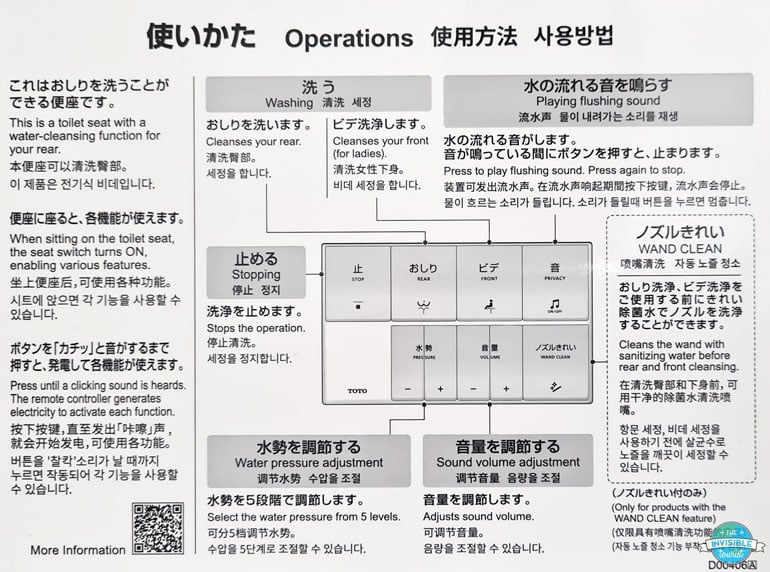
22. Do support local businesses when souvenir shopping
As far as do’s and don’ts in Japan are concerned, there are so many beautifully hand-crafted and traditional souvenirs.
Do support local businesses by saving a little room in your suitcase for meaningful souvenirs such as folding fans, watercolour paintings, wooden items, lucky charms, stationery and ceramics. This will help to keep centuries-old traditions alive.
TIP: My detailed souvenir guide for Japan covers all the traditional souvenirs, what they mean and where you can find them!

23. Do browse or shop in major department & electronics store
If you’re wanting to fill some time between attractions or are just curious, head to a Japanese department store to be blown away. I dare you to shop in LABI electronics without losing your mind over the sheer amount of stuff available or the store’s quirky theme song.
Some of the major department stores are actually owned by and share the same names as private rail lines, such as Odakyu. The sell everything from luxury fashion to streetwear, home goods to electronics, even some of the most enticing-looking food graces their basement floors.
Ginza in Tokyo is known for its department stores that have lengthy history. Some of my personal favourites are:
- Isetan & Mitsukoshi
- Matsuya Ginza
- Yamada Denki LABI
- BIC Camera (the Shinjuku branch has a bar serving drinks inside when you walk through the entrance)
- Yodobashi Camera
- Don Quijote (not quite a department store, but has enough things to seem like one!)
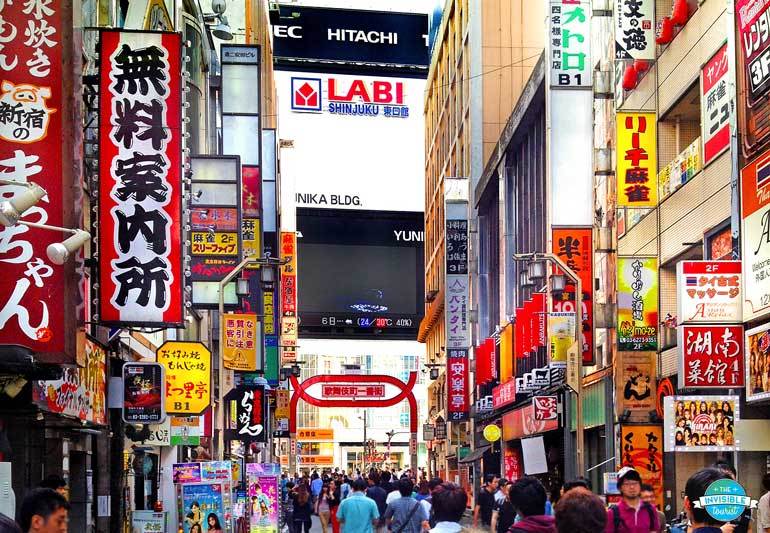
24. Do dress somewhat conservatively (and smartly)
Women in Japan dress somewhat conservatively in the sense that they cover their shoulders and chests. It is pretty rare to see cleavage on Japanese women. Contrary to this though, short shorts are VERY popular!
As a foreigner, no one will really mind if your shoulders are showing but pregnant women should definitely try to shy away from tight-fitting clothing that accentuate their baby bumps. Locals will frown on this, so try to find some flowy dresses or loose tops.
Also, Japanese people tend to dress quite smartly, especially in larger cities like Tokyo and Osaka. Smart casual dress will be fine.
If you can avoid wearing active wear when you’re wandering the streets and not hiking, that will help you not “stand out” as tourist, too. This is one of my top tips for how to not look like a tourist anywhere.
Shoes off indoors
This is one of the unspoken rules to follow in Japan. At a lot of temples, you will be expected to leave your shoes outside as they are seen as dirty. Ensure you bring some socks along with you if you prefer not to have bare feet.
A good indication of whether you need to take your shoes off or not is by looking at what the locals are doing. If their shoes are outside then leave yours there, too.
This also extends to changerooms in retail, restaurants with tatami mats and bathrooms in your hotel. There are usually slippers you can wear specifically inside the bathroom so you don’t tread outside dirt from your shoes on the floor.
TIP: Wondering what to add to your Japan packing list? My guide to what to pack for Japan covers quite a few things you probably haven’t thought of. It also details what NOT to wear and bring, so take a look to learn more.
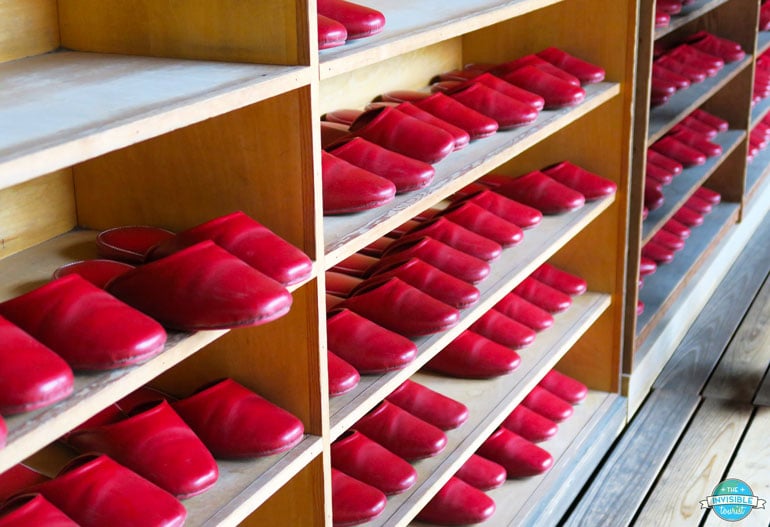
25. Be mindful of your phone usage in areas of respect
At temples, shrines and other areas of respect, try to remember to turn your phone onto silent before heading in. The amount of people making and accepting calls in these otherwise tranquil settings is very impolite.
In my opinion, the noise defeats the purpose of what the areas of respect were created for. We wouldn’t do this at our local church, so please show respect to the site and its worshippers.
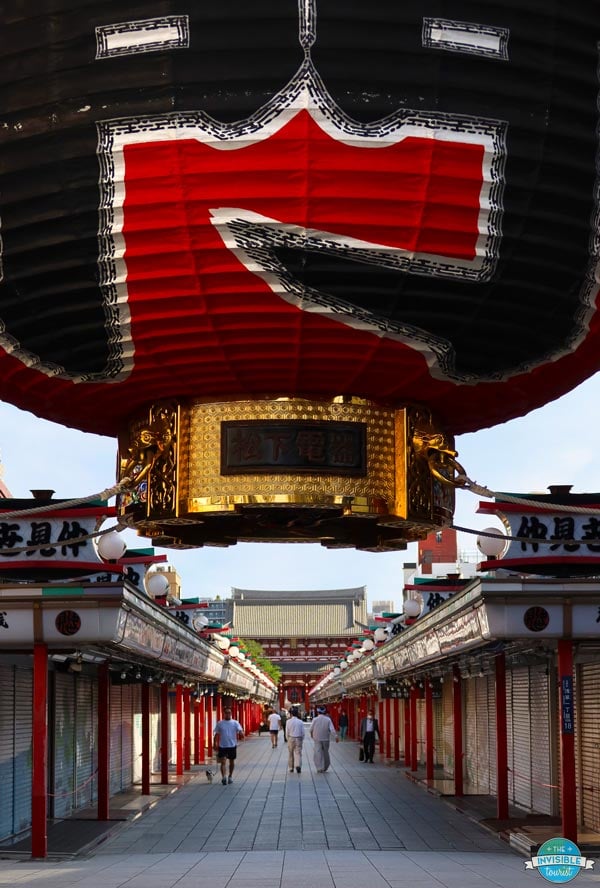
26. Don’t wear perfume when eating sushi
Yes, this is one of the things to avoid in Japan, especially at sushi restaurants! Locals believe that sushi should be enjoyed not only with your taste buds, but also your nose.
Even the hint of perfume, aftershave or strong deodorants can alter the delicate aroma of sushi, so wearing scents should be avoided not only for yourself but for the experience of others.

27. Do step outside your comfort zone
Japan is home to some of the most quirky, unique and interesting experiences on the planet. Take a step outside your comfort zone and try something new – you’ll never know if you like it unless you try!
Doing so can give us a whole new understanding about different cultures and introduce us to new ways of thinking.
Spend the night in a capsule hotel, bathe in your birthday suit at one of the best onsen in Japan, experience a Maid Café, eat delicacies such as eel on a Shibuya street food tour, dress up as a ninja and learn their tricks, jump on a rollercoaster int the middle of Tokyo… the list is endless!
In my opinion, the Robot Restaurant in Shinjuku, Tokyo was by far one of the most quirky and fun things to do in Japan in its heyday. Even the waiting room itself was the biggest sensory overload with its ceiling covered in bling, flashy lights and TV screens as well as funky music. It really had to be seen to be believed!
NOTE: The Robot Restaurant has reopened and is now 18+ only! Buy discounted tickets in advance here.

28. Do research your preferred destinations in Japan
To avoid looking like a tourist in Japan, or anywhere really, it’s imperative to do some research before you go.
In online travel forums and groups I see all too often people landing in Japan then freaking out asking for help because they don’t know how to get from the airport to the city, their Airbnb had been cancelled (more on this below), they’ve no clue where to eat or even what to do.
How people make the choice to travel this way will always baffle the heck out of me (each to their own I guess), but the point is to know all this BEFORE you arrive to make the most efficient use of your travel time when you’re there.
Ask yourself this: Do you really want to spend precious moments wasting the day figuring out what to do?
I can help you get off to a good start with my detailed Japan travel guides that cover how to get from airports and train stations to city centres, how long it takes, costs involved plus all the best things to do!
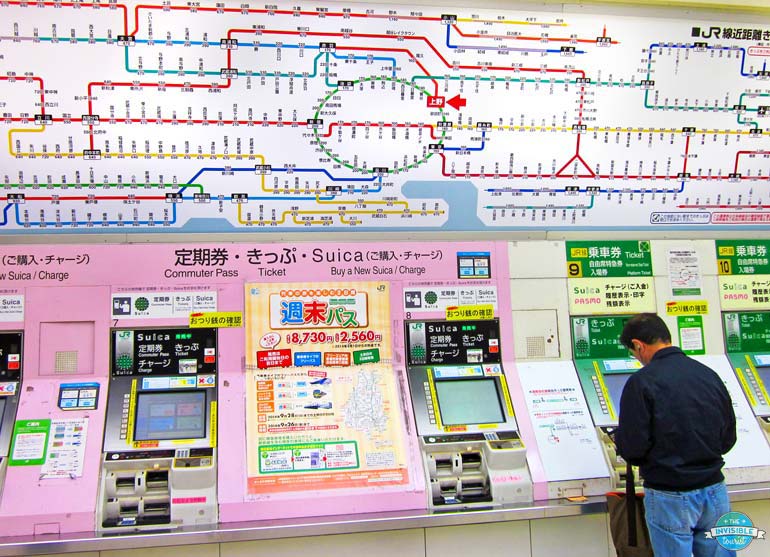
29. Do book your Japan accommodation in advance
Having your accommodation options sorted in advance will help to avoid unnecessary stress. As a general rule that goes against what many others say, I recommend it’s best to avoid using Airbnb in Japan due to a law that was passed in June 2018. In my opinion, the risk is not worth it. The whole point of a holiday is to escape from stress, right?
Click here for alternative accommodation options in Japan to suit your budget
In terms of pre-purchased rail passes, contrary to popular belief, you may not need a Japan Rail Pass for your visit especially if you’re travelling with a mid-range budget. Again, this also goes against everything you may have already read so find out why at the conclusion of my 2 weeks in Japan itinerary.
Click here for other types of passes available in Japan for pre-purchase
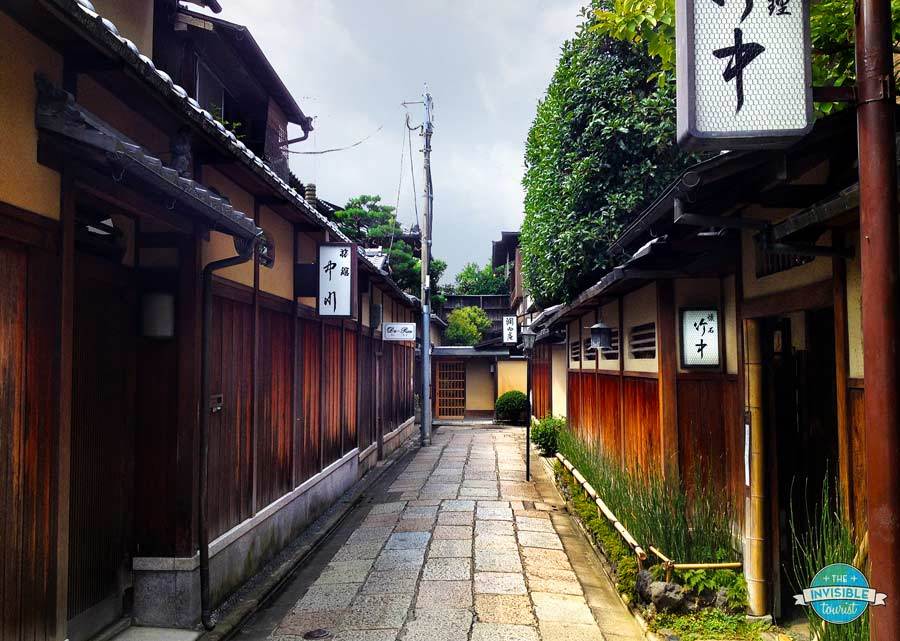
30. Do purchase tickets and passes in advance
Popular attractions including Shibuya Sky, Tokyo SkyTree, Disneyland, Osaka’s Universal Studios and more allow you to buy tickets in advance. This can save you lots of time and stress if you’re organised before your trip.
|
Click on a link below to buy your tickets in advance or get some ideas and inspiration for things to do in Japan! Tokyo inspiration for things to do & tickets to book in advance → Kyoto inspiration for things to do & tickets to book in advance → Osaka inspiration for things to do & tickets to book in advance →
|
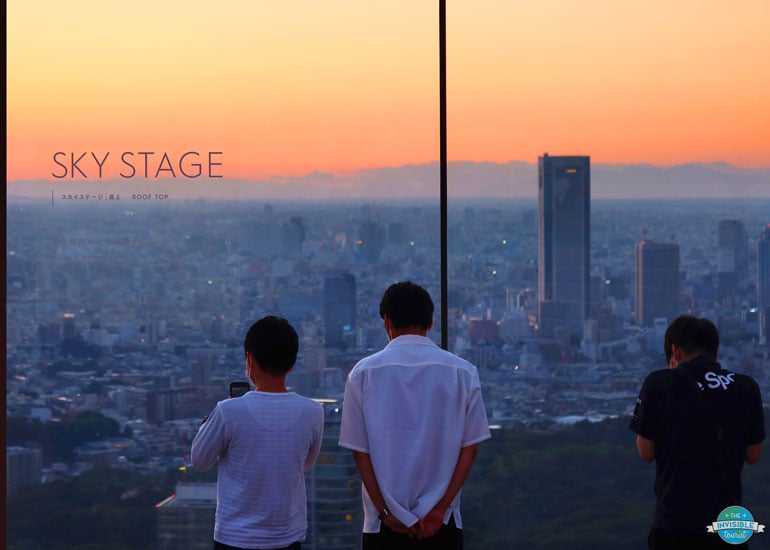

31. Do have a prepared Japan itinerary
Another way to prepare for your Japan trip is to have an itinerary organised. Does the task of putting together a Japan itinerary seem a bit overwhelming to you? It doesn’t have to be!
My personal, tried-and-tested Japan ItinerariesI’ve got you covered with my personal and detailed guides to this amazing country. I’ve shared hidden gems, efficient itineraries, insider tips and loads more. Go take a look: Click here for my full Japan Guides & Itineraries → Click here for my ad-free offline PDF itineraries to use in Japan →
|
I’m a weirdo who LOVES creating itineraries so just think of me as your Japan travel planner 😊

Concluding the do’s and don’ts in Japan
I hope this overview of travel etiquette in Japan has helped you feel more confident about your upcoming trip. Despite a few cultural differences to the West, it’s really easy travelling in Japan like a local if you are well prepared. You can do your best to blend in in Japan and not stand out for the wrong reasons.
By following these Japanese rules for foreigners, you’ll be practising good manners and etiquette in Japan. And now you know exactly how to be a good tourist in Japan, may the odds ever be in your favour.
How is your Japan trip planning coming along? I’ve got you covered for where to stay in Tokyo, shared how to learn Japanese for tourists (and free cheat sheet!), detailed itineraries and much more on my Japan travel blog. Take a look once you’re done here for more ideas!
Is there anything you wish you knew before visiting Japan? What do you think of these do’s and don’ts? Do you have any other points you would like to add to this list? Let me know!
If you enjoyed this Japan tourist guide or are planning to use it on your trip, I’d love if you could share it around. Feel free to come and join me on Facebook, Pinterest, Instagram or TikTok for more Japan travel inspiration!
Until next time,

Read my Tokyo Treat review and get popular Japanese snacks delivered here, or read my Sakuraco review and get traditional Japanese sweets delivered here!
Like it? Pin it! 📌


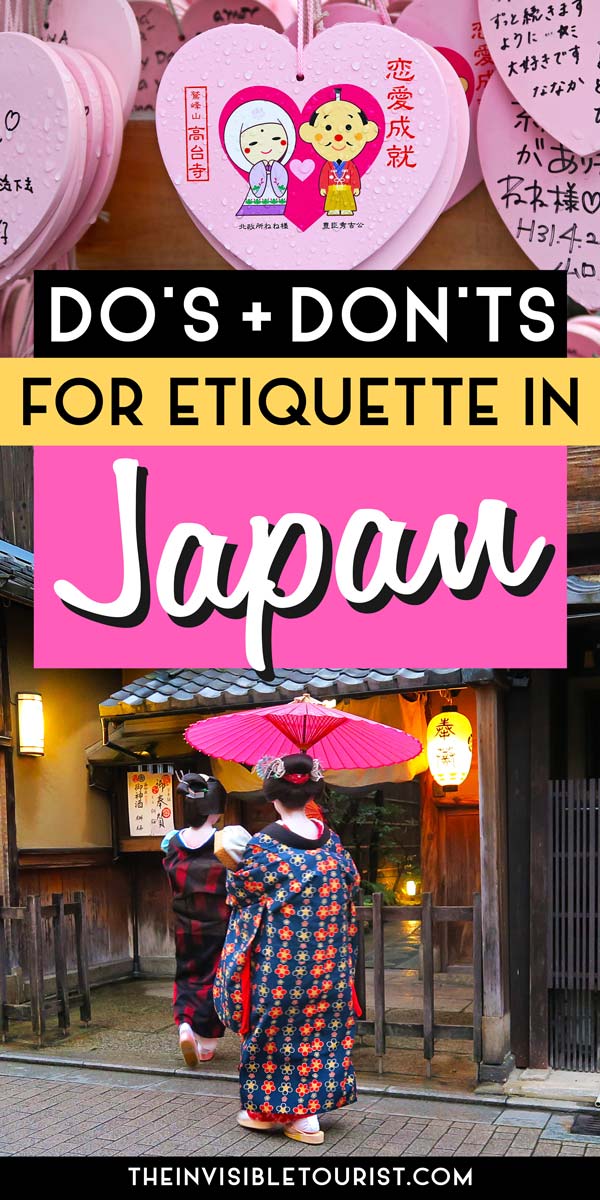
Featured image and first pin credit: Unsplash
This guide to tourist etiquette in Japan contains some affiliate links, at no extra cost to you. I may earn a small commission if you decide to make a purchase and if you do, thanks for your support! This helps with the costs of running my blog so I can keep my content free for you. As always, I only recommend a product or service that I genuinely love and use myself!


Hello there,
Your post is so detailed and helpful. Thank you. My husband and I are planning a trip to Japan with our two daughters (Ages 17 and 13). Our youngest has many food allergies (in particular, food degradation in meats and prepackaged dish prep items such as sauces/mixes/flavorings). Needless to say she eats very cleanly with fresh frozen meats and just salt, butter, oil and fruit juices, and dairy to accentuate her dishes. Do you have any suggestions on how to handle this type of extreme allergy in Japan? We would love to go and see the Ghibli Museum but have held off because of her dietary issues.
Hi Charle,
This is not my area of expertise, I do have some suggestions but highly recommend doing some more research into this 🙂
You won’t need to worry about food degradation in Japan, as the majority of places have high turnover of their food and it’s cooked fresh on the spot. Just stick to places that are busy with locals and your daughter will be fine in that regard.
In terms of allergens in the sauces, you can bring along some little cards with translations into Japanese to show the staff when you’re ordering.
You can print out the relevant ones to your daughter here.
For more detailed info on how to navigate this issue in Japan, this is also a great resource.
I hope that helps and you have a wonderful trip!
Great and useful information about travelling through Japan! Thank you for this. Keep traveling and guide amateurs like us 🙂
So glad you found my etiquette guide helpful, Tim! Thanks for your comment 🙂
I’ll be taking my second trip to Japan in April, and my first solo trip (my husband won’t be coming until a week later) and I can confirm that dressing conservatively, having good walking shoes (so. much. walking.) and a plan is important.
One of the things I loved about my last visit was their escalator etiquette. Stand on the left side so people in a hurry can run up the right. So simple! It took me a few tries to remember, but I find myself doing it naturally back in the states.
Oh my gosh, I completely agree with you about the escalators Bekki! It’s like magic that everyone sticks to the one side. Being from Australia we also keep to the left, but on weekends the “non-corporates” tend to stand all over the place which can be annoying here. So glad it’s standard in Japan, it’s a luxury. Thanks for your comment and enjoy Japan the second time around 🙂
Thanks for this.. Surely, I will do the don’ts if I am not reading this. Very informative.
I’m sure you will be fine, Juana. So glad you found these helpful!
How do you recommend a tourist get around with a major food allergy? My husband is severely allergic to nuts (and also allergic to shellfish). We plan to travel around Tokyo + also hit TokyoDisney. He’s increasingly worrying about how to handle food and ordering and purchasing snacks, even. Any tips?
That’s a great question to ask, Amber! Allergies to nuts do not seem to be as common in Japan as they are in the West, so it’s definitely wise to learn the Japanese phrase for “I’m allergic to”. In your husband’s case, if he can master this phrase he should be able to get his message across. The key words are:
Watashi wa = I am
Arerugii = Allergy
Nuts: Nattsu
Shellfish: Kai
The phrase would be:
私はナッツアレルギーがあります。
Watashi wa nattsu arerugii ga arimasu.
“I am allergic to nuts”.
or,
私は貝アレルギーがあります
Watashi wa kai arerugii ga arimasu.
“I am allergic to shellfish”.
If that sounds a bit challenging, copy and paste the text and print it out on a little card/piece of paper to take along with you to hand to staff when you’re ordering food.
He can also use “taberaremasen 食べられません” which literally translates to “can’t eat” if that makes things easier.
I hope this helps and you have a great trip! 🙂
This is great! Thank you so much for all the time and consideration you put into these posts, and for updating them! I’m going to Japan in May and wondered if you have any “don’ts” for clothing. I know in Thailand we could not go into certain Temples because I was wearing workout pants. Any rules like this in Japan?
So glad you found this helpful, Samantha! I love tying to help my readers be as prepared as possible before travelling 🙂 Actually I have been meaning to include a few extra points to this post (I’ll have to get around to that!) but yes, there are some don’ts for clothing.
In a lot of temples, you will be expected to leave your shoes outside as they are seen as dirty, so make sure you bring some little socks along with you if you prefer not to have bare feet. A good indication of whether you need to take your shoes off or not is obviously by looking at what the locals are doing. If their shoes are outside then leave yours there, too 🙂
Women in Japan dress somewhat conservatively in the sense that their cover their shoulders and chests. You won’t really see cleavage in Japan – but contrary to this short shorts are VERY popular! As a foreigner, no one will really mind if your shoulders are showing but pregnant women should definitely try to shy away from tight-fitting clothing that shows off their baby bumps. Locals will frown on this, so try to find some flowy dresses or loose tops.
Also, the Japanese tend to dress quite smart, especially in larger cities like Tokyo and Osaka. Smart casual dress will be fine, and if you can avoid wearing active wear that will help you not “stand out” as tourist. I hope that helps and you have a brilliant time in Japan in May, thanks for your comment! 🙂
This, by far, is the most detailed post I’ve stumbled upon! Thank you for all these. Even as an Asian, I feel quite intimidated travelling to other Asian countries. But I’m excited creating our itinerary especially all the info are available. Btw, I read an article before that the reason why it’s illegal to jaywalk in Japan is because if there are children watching and you cross the street while red lights are on (and even if there are no cars moving), they might copy you. 🙂 Thanks again and hope you’d visit Philippines too 😀
Aww, thank you for the lovely compliment, Marielle! I am SO happy to hear this post has helped you with your Japan planning 🙂 I agree, it cam seem a little intimidating if you’re not sure what to expect so it’s great you’re doing your research first so the correct etiquette doesn’t seem so daunting.
Ah, thank you for letting me now about jaywalking and children – that makes sense! I hope you have a wonderful time in Japan (and yes, I’d LOVE to visit Philippines someday!) 😀
Wow such a detailed and informative post. I do hope to visit Japan some day and I know for sure I will be reading your guides.
Thanks so much, Nicola! I hope you get to visit Japan soon 🙂
These are some great tips! I was just doing some research about going to Japan so I will definitely pin this for later! Thanks for sharing.
So glad to hear that! Good luck with your Japan travel planning 🙂 Thanks for your comment, Odette!
This is such an interesting post and to see the RWC here in 2020 entices me especially as we will be celebrating an important wedding anniversary. Thank you. So helpful. Kx
Oh wow, how exciting for you, Karen! So glad you found this helpful 🙂
Found this so fascinating, especially the chopsticks advice! I am away to binge read all your Japan posts as we are hoping to go next year!
Ooooh awesome, thank you Lauren! Yes some of these do’s and don’ts are pretty fascinating from a Western perspective, but it’s so good to know 🙂
Great information, really handy for anyone visiting Japan! I love their vending machines, they look awesome!
Thanks, Danielle! Oh my gosh the vending machines are next level in Japan ?
As someone who lived in Japan for two years, I agree with all of these. Well done! Japan’s culture intimidates a lot of people, but really, just exercise common sense respect and curtesy, you’d be fine 🙂 Except the slurping noodles bit haha
That makes me really happy Viola, thank you! I agree, it can seem intimidating at first for those who aren’t aware of the etiquette and manners but once you know why, things makes sense. Haha yes, hearing people slurping noodles when eating out is pretty funny if you’re not used to it! Thanks for your comment 🙂
Thank you for writing this thorough list! I’d already known many of these growing up with a good number of Japanese friends but this was a great refresher. I definitely want to hit up that robot restaurant, it looks super cool!
The Robot Restaurant has got to be one of the most crazy, fun and memorable experiences I had in Japan – there is really nothing else like it! I hope you get to see it in person yourself someday 🙂
I felt pretty good after reading this, because I actually knew most of these. Probably because I grew up in the very much Japanese-influenced Hawaii.
That’s so awesome to hear, Sarah! You would be a great Invisible Tourist in Japan, hehe. Hawaii is beautiful, lucky you to have grown up there 🙂
Such an informative post! I have not yet been to Japan and especially didn’t realise that eating whilst walking and leaving a tip were considered bad manners. Will keep these in mind!
So glad you think so! Yes, the no walking when eating is a bit surprising at first but it makes sense once you know why. And as a tourist the whole no tipping thing is great too! Thanks for your comment 🙂
Presumably, don’t talk about WW2 is in there as a hidden extra.